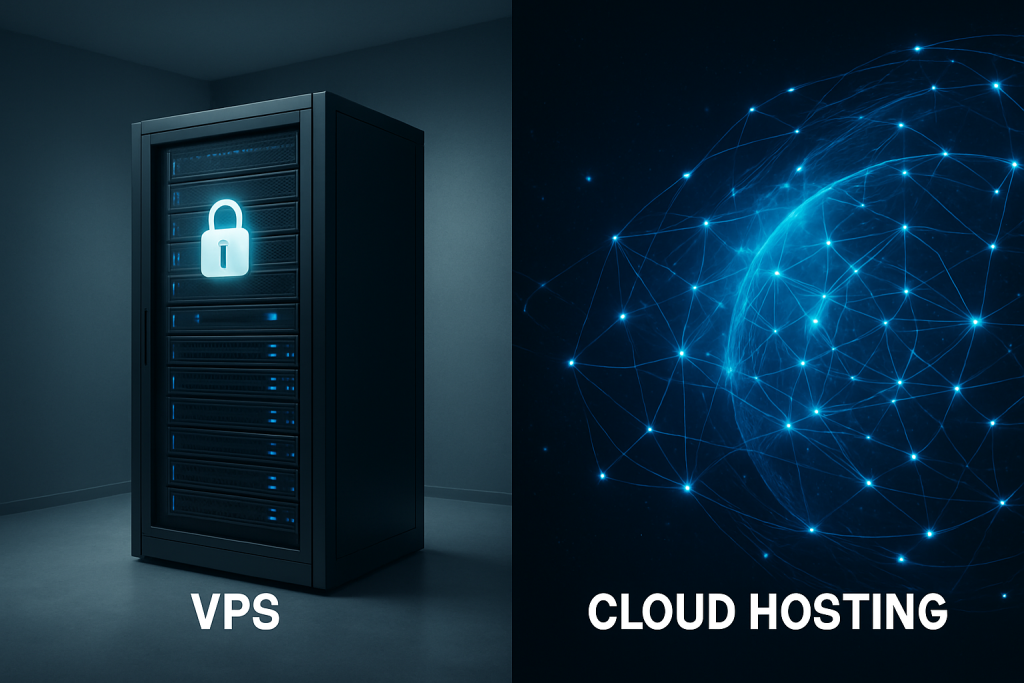The digital world is all about speed, flexibility, and growth. If your website, application, or business is growing, you’ve likely outgrown basic Shared Hosting and now face a critical choice: Virtual Private Server (VPS) or Cloud Hosting?
This decision is more than just a technical preference; it’s a foundational business strategy. Choose wrong, and you might face slow loading times, unexpected downtime, or crippling cost spikes. Choose right, and you’ve built a powerhouse foundation for exponential growth.
As a hosting expert who has spent years navigating these infrastructures, I’m going to break down the complex differences between VPS and Cloud Hosting in simple, human English. We’ll look past the marketing hype and focus on what truly matters in 2025: reliability, scalability, performance, and cost predictability.
This is the definitive guide you need to make the right choice for your future.
Part 1: Understanding the Foundation—The Architecture Analogy
To truly understand the difference between VPS and Cloud Hosting, let’s use a simple, real-world analogy. Forget the jargon for a minute and picture a neighbourhood.
1. The VPS (Virtual Private Server): Your Own Apartment in a Skyscraper
Imagine a massive, high-end apartment building—that’s the Physical Server.
- You rent an apartment (your VPS): This apartment is entirely yours. It has a locked door, its own dedicated utility connections (CPU, RAM, Storage), and you can paint the walls (install your own OS and software) however you like.
- The resources are fixed: If your lease says you have 1,000 square feet, that’s all you have. If your business suddenly needs 2,000 square feet next week, you have to contact the building manager, sign a new lease, move all your furniture, and get a bigger apartment on a different floor. There will be some effort and likely a bit of downtime during the move.
- Reliability: The stability of your apartment is tied to the stability of the building. If the main power generator in your building fails, your apartment loses power, and your website goes down until the single, physical server is fixed.
In Short: A VPS is one large physical server sliced into isolated, dedicated virtual pieces. It offers predictable resources, a fixed cost, and high control, but its scalability is manual, and its reliability is tied to that single physical machine.
2. The Cloud Hosting: A Network of Interconnected Skyscrapers (The City Grid)
Now, picture an entire, sprawling, modern city, complete with interconnected power grids, emergency backup systems, and shared resource pools—that’s Cloud Hosting.
- Your service is the City Grid: Your website doesn’t live in one building; it’s spread across an entire network of them (the server cluster).
- The resources are dynamic: When you need more power (a traffic spike), the system instantly pulls extra electricity from the entire city grid and directs it to your service. You don’t sign a new lease; the utility meter simply goes up, and you get billed for the extra usage—the pay-as-you-go model.
- Reliability (Fault Tolerance): If one building (server) catches fire or loses power, the system instantly switches your service to a different building down the street (a different server in the cluster) without any downtime. This is known as automatic failover or redundancy.
In Short: Cloud hosting is a distributed network of many servers working together. It offers real-time, on-demand scalability, superior reliability, and dynamic resource allocation, but it comes with variable costs and often less raw, low-level control than a traditional VPS.
Part 2: The Critical Comparison—Eight Key Metrics in 2025
Now that we understand the architecture, let’s compare these two options across the eight factors that matter most to a modern online business.
Metric 1: Scalability (The Growth Factor)
| Feature | Virtual Private Server (VPS) | Cloud Hosting |
| Concept | Vertical Scaling (Upgrading to a bigger apartment). | Horizontal Scaling (Instantly spinning up more mini-servers). |
| How it Works | Manual: You must upgrade your plan (CPU, RAM, Storage). This usually involves a server reboot or migration and can cause a few minutes of downtime. You are limited by the physical server’s maximum capacity. | Automatic/Real-Time: Resources (CPU/RAM) are pooled and dynamically allocated on-demand. You can add more power instantly without a reboot or downtime. |
| Verdict | Cloud Wins: If your traffic is unpredictable (e-commerce sales, viral content, holiday spikes), Cloud’s elasticity is an absolute game-changer. |
Metric 2: Reliability and Uptime (The Downtime Risk)
| Feature | Virtual Private Server (VPS) | Cloud Hosting |
| Infrastructure | Single Point of Failure: Relies on one physical host server. If that server has a hardware failure (disk drive, power supply), your website is offline. | Redundant Cluster: Data is mirrored across multiple physical servers. If one server fails, the others immediately take over with automatic failover. |
| Uptime Guarantee | Typically 99.9% | Often 99.99% or 99.999% (Near-perfect) |
| Verdict | Cloud Wins: For mission-critical applications where every minute of downtime costs you money (e-commerce, SaaS), the built-in redundancy of the Cloud is non-negotiable. |
Metric 3: Cost Structure (The Budget Factor)
| Feature | Virtual Private Server (VPS) | Cloud Hosting |
| Pricing Model | Fixed Monthly Rate: You pay a flat fee for your allocated resources, regardless of whether you use them all. | Pay-As-You-Go (Consumption-Based): You pay only for the resources you actually consume, often billed hourly or per minute. |
| Budgeting | Predictable: Ideal for fixed budgets and websites with steady, known traffic patterns. | Variable: Lower costs during low-traffic periods, but costs can spike unexpectedly during high-traffic surges. Requires more careful monitoring. |
| Verdict | VPS Wins for Budget Predictability: If you have a strict, fixed budget and consistent traffic, the VPS flat rate gives you peace of mind. Cloud Wins for Efficiency: If you often have periods of low usage, the Cloud can be cheaper as you only pay for what you use. |
Metric 4: Performance (Speed and Responsiveness)
| Feature | Virtual Private Server (VPS) | Cloud Hosting |
| Resource Isolation | Excellent isolation on a single machine. Performance is consistent up to your allocated limits. | Excellent overall performance, leveraging load balancers and CDNs (Content Delivery Networks). |
| During High Traffic | Risk of Saturation: If your dedicated resources are exceeded, the server will slow down or crash, potentially affecting your neighbours on the same physical server (the “noisy neighbour” effect). | Superior Handling: Traffic is distributed across the server network, preventing a single server from becoming overloaded. Performance remains high. |
| Verdict | Cloud Wins: While a well-optimized VPS is fast, the Cloud’s ability to instantly scale and distribute load ensures sustained, optimal performance even during peak hours. |
Metric 5: Control and Customization
| Feature | Virtual Private Server (VPS) | Cloud Hosting |
| Access Level | Full Root Access. You are the system administrator. | Often full root access, but some managed platforms may limit deep backend configuration to simplify the user experience. |
| OS/Software | Maximum Freedom: Install any Operating System, custom kernel, or obscure software you need. Perfect for developers. | High Freedom: Generally allows custom OS images, but the focus is often on pre-configured, optimized stacks. |
| Verdict | VPS Wins: If you are a seasoned developer, have an in-house IT team, or need a highly specific, customized server environment (like a unique game server or a complex database), VPS offers the ultimate level of control. |
Metric 6: Technical Management (Ease of Use)
| Feature | Virtual Private Server (VPS) | Cloud Hosting |
| Management Type | Typically Unmanaged or Semi-Managed. You are responsible for the Operating System, security patches, updates, and maintenance. | Often Managed: Cloud platforms frequently include automation tools, automated backups, and integrated managed services, making it easier for non-experts. |
| Complexity | High: Requires significant technical skill and constant attention. | Moderate-High: The architecture is complex, but the user interface is often simplified by the provider (e.g., automated backups, one-click deploys). |
| Verdict | Cloud Wins for Ease-of-Use: If you don’t have a dedicated system administrator, a Managed Cloud or even a simple Cloud VPS will dramatically reduce your administrative overhead. |
Metric 7: Backups and Disaster Recovery
| Feature | Virtual Private Server (VPS) | Cloud Hosting |
| Data Protection | Backups are often an add-on service you must configure yourself (unless fully managed). Recovery is manual, involving reloading a snapshot of your single server. | Integrated: Built-in automatic backups, snapshots, and replication across the entire server cluster. Disaster Recovery is instant and automatic (failover). |
| Verdict | Cloud Wins: The entire architecture is built on redundancy, offering superior peace of mind and faster recovery in a disaster scenario. |
Metric 8: The Future in 2025 (The Trend)
The hosting world is moving unequivocally toward flexibility and automation.
- Cloud Hosting is the clear trendsetter. It’s embracing Artificial Intelligence (AI) for real-time resource optimization, security monitoring, and predictive scaling. Its consumption-based model perfectly aligns with modern business finance models (OpEx over CapEx).
- VPS Hosting is adapting. Many modern VPS providers now offer “Cloud VPS” packages, which attempt to bridge the gap by offering faster resource scaling and better redundancy, but they are still fundamentally limited by their underlying virtualization method (typically being tied to a single physical machine, even if that machine is part of a larger network).
Part 3: The Final Decision Matrix—Which One is Right for You?
Choosing your hosting solution comes down to prioritizing three things: Budget Predictability, Scalability, and Technical Control.
Choose VPS Hosting If…
| Scenario | Best Fit For | Why? |
| Steady Traffic & Predictable Growth | Small to medium-sized businesses, static informational websites, blogs, and corporate sites with established traffic. | The fixed monthly rate is perfect for a tight, predictable budget. You know exactly what you’re paying every month. |
| Advanced System Control is Needed | Experienced developers, IT professionals, or agencies needing to run highly specialized, custom environments (specific Linux distributions, legacy applications, unusual port configurations). | Full root access gives you maximum flexibility to tweak and optimize the entire server environment. |
| Outgrowing Shared Hosting (Budget Step) | This is your first upgrade from Shared Hosting. You need better isolation and speed but want to keep costs predictable. | VPS is the classic, reliable middle-ground solution. |
| Security Compliance Requirement | You need to lock down a highly customized, specific environment where you control every single security layer and patch. | The complete isolation on a single server, where you control the OS, gives you total oversight. |
Choose Cloud Hosting If…
| Scenario | Best Fit For | Why? |
| Variable/Unpredictable Traffic | E-commerce stores (especially during holiday sales), viral content platforms, news sites, and media outlets. | The ability to instantly scale resources prevents crashes and ensures your site remains fast and responsive under any load. |
| Mission-Critical Uptime | SaaS (Software as a Service) platforms, high-traffic applications, and any business where downtime directly translates to revenue loss. | Automatic failover and redundancy guarantee near-perfect uptime (99.99%+), ensuring business continuity. |
| Global Reach is Essential | You have an international customer base and need your content delivered rapidly worldwide. | Cloud platforms easily integrate with CDNs and offer multiple data center locations globally, optimizing speed for all your users. |
| Focus is on Development, Not Maintenance | You want to spend time building your product/website and minimal time on server maintenance. | Managed Cloud platforms handle most patching, backups, and infrastructure maintenance, freeing up your team. |
The Hybrid Reality of 2025
In 2025, the lines are blurring. The most common solution for many growing businesses is often a Hybrid Cloud approach:
- Use a standard VPS for the stable, low-traffic parts of your operation (e.g., the company CRM, internal tools, test environments).
- Use Cloud Hosting for the critical, high-traffic, and unpredictable parts (e.g., your main e-commerce storefront, your core user-facing application).
This strategy gives you the best of both worlds: cost predictability for your steady-state operations and unlimited elasticity for your peak performance needs.
Part 4: Actionable Checklist for Your Hosting Move
Before you sign a contract, use this final checklist:
- Forecast Your Traffic: Look at the last year. If traffic has steady 10-20% month-over-month growth, VPS is fine. If you see spikes of 100-300% (sales, marketing campaigns), you need Cloud.
- Define Your Admin Capacity: Do you have a technical person on your team who knows how to run a Linux/Windows server (patching, security, monitoring)?
- Yes: VPS (Unmanaged or Semi-Managed) is viable.
- No: Choose Cloud (or a fully Managed VPS/Cloud solution).
- Evaluate Downtime Cost: If your site is down for 1 hour, how much money do you lose?
- Low/Minor: VPS is acceptable.
- High/Critical: Cloud’s redundancy is mandatory.
- Confirm the Pricing: If you choose Cloud, set up a budget alert with your provider. Don’t let a major traffic spike result in a massive surprise bill. Understand the exact cost per minute for your resources.
- Ask About the SLA: What is the Service Level Agreement (SLA)?
- A good VPS SLA will guarantee 99.9% uptime.
- A good Cloud SLA will guarantee 99.99% or higher and specify automatic failover procedures.
The right hosting choice isn’t about choosing the “newest” or the “cheapest.” It’s about choosing the infrastructure that best supports your unique business model, financial needs, and growth projections for 2025 and beyond.



